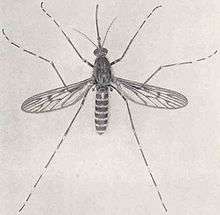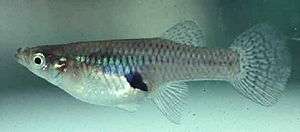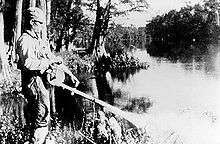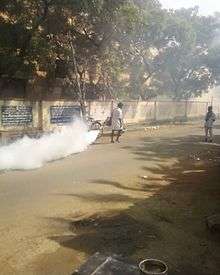Mosquito control

Mosquito control manages the population of mosquitoes to reduce their damage to human health, economies, and enjoyment. Mosquito control is a vital public-health practice throughout the world and especially in the tropics because mosquitoes spread many diseases, such as malaria and the Zika virus.
Mosquito-control operations are targeted against three different problems:
- Nuisance mosquitoes bother people around homes or in parks and recreational areas;
- Economically important mosquitoes reduce real estate values, adversely affect tourism and related business interests, or negatively impact livestock or poultry production;
- Public health is the focus when mosquitoes are vectors, or transmitters, of infectious disease.
Disease organisms transmitted by mosquitoes include West Nile virus, Saint Louis encephalitis virus, Eastern equine encephalomyelitis virus, Everglades virus, Highlands J virus, La Crosse Encephalitis virus in the United States; dengue fever, yellow fever, Ilheus virus, malaria, Zika virus and filariasis in the American tropics; Rift Valley fever, Wuchereria bancrofti, Japanese encephalitis, chikungunya and filariasis in Africa and Asia; and Murray Valley encephalitis in Australia.
Depending on the situation, source reduction, biocontrol, larviciding (killing of larvae), or adulticiding (killing of adults) may be used to manage mosquito populations. These techniques are accomplished using habitat modification, pesticide, biological-control agents, and trapping. The advantage of non-toxic methods of control is they can be used in Conservation Areas.
Monitoring mosquito populations
Adult mosquito populations may be monitored by landing rate counts, or by mechanical traps. For landing rate counts, an inspector visits a set number of sites every day, counting the number of adult female mosquitoes that land on a part of the body, such as an arm or both legs, within a given time interval. Mechanical traps use a fan to blow adult mosquitoes into a collection bag that is taken back to the laboratory for analysis of catch. The mechanical traps use visual cues (light, black/white contrasts) or chemical attractants that are normally given off by mosquito hosts (e.g., carbon dioxide, ammonia, lactic acid, octenol) to attract adult female mosquitoes. These cues are often used in combination.
Monitoring larval mosquito populations involves collecting larvae from standing water with a dipper or a turkey baster. The habitat, approximate total number of larvae and pupae, and species are noted for each collection. An alternative method works by providing artificial breeding spots (ovitraps) and collecting and counting the developing larvae at fixed intervals.
Source reduction
Since many mosquitoes breed in standing water, source reduction can be as simple as emptying water from containers around the home. This is something that homeowners can accomplish. Mosquito breeding grounds can be eliminated at home by removing unused plastic pools, old tires, or buckets; by clearing clogged gutters and repairing leaks around faucets; by regularly (at most every 4 days) changing water in bird baths; and by filling or draining puddles, swampy areas, and tree stumps. Eliminating such mosquito breeding areas can be an extremely effective and permanent way to reduce mosquito populations without resorting to insecticides. However, this may not be possible in parts of the developing world where water cannot be readily replaced due to irregular water supply.
Open water marsh management (OWMM) involves the use of shallow ditches, to create a network of water flow within marshes and to connect the marsh to a pond or canal. The network of ditches drains the mosquito habitat and lets in fish which will feed on mosquito larvae. This reduces the need for other control methods such as pesticides. Simply giving the predators access to the mosquito larvae can result in long-term mosquito control.[1] Open-water marsh management is used on both the eastern and western coasts of the United States.
Rotational impoundment management (RIM) involves the use of large pumps and culverts with gates to control the water level within an impounded marsh. RIM allows mosquito control to occur while still permitting the marsh to function in a state as close to its natural condition as possible. Water is pumped into the marsh in the late spring and summer to prevent the female mosquito from laying her eggs on the soil. The marsh is allowed to drain in the fall, winter, and early spring. Gates in the culverts are used to permit fish, crustaceans, and other marsh organisms to enter and exit the marsh. RIM allows the mosquito-control goals to be met while at the same time reducing the need for pesticide use within the marsh. Rotational impoundment management is used to a great extent on the east coast of Florida.
Biocontrol

Biological control or "biocontrol" is the use of natural enemies to manage mosquito populations. There are several types of biological control including the direct introduction of parasites, pathogens and predators to target mosquitoes. Effective biocontrol agents include predatory fish that feed on mosquito larvae such as mosquitofish (Gambusia affinis) and some cyprinids (carps and minnows) and killifish. Tilapia also consume mosquito larvae.[2] Direct introduction of tilapia and mosquitofish into ecosystems around the world have had disastrous consequences.[3] However, utilizing a controlled system via aquaponics provides the mosquito control without the adverse effects to the ecosystem.
Other predators include dragonfly (fly) naiads, which consume mosquito larvae in the breeding waters, adult dragonflies, which eat adult mosquitoes, and some species of lizard and gecko.[4] Biocontrol agents that have had lesser degrees of success include the predator mosquito Toxorhynchites and predator crustaceans—Mesocyclops copepods,[5] nematodes and fungi.[6] Predators such as birds, bats, lizards, and frogs have been used, but their effectiveness is only anecdotal.
Like all animals, mosquitoes are subject to disease. Invertebrate pathologists study these diseases in the hope that some of them can be utilized for mosquito management. Microbial pathogens of mosquitoes include viruses, bacteria, fungi, protozoa, nematodes and microsporidia.[7][8]
Dead spores of the soil bacterium Bacillus thuringiensis, especially Bt israelensis (BTI) interfere with larval digestive systems. It can be dispersed by hand or dropped by helicopter in large areas. BTI loses effectiveness after the larvae turn into pupae, because they stop eating.
Two species of fungi can kill adult mosquitoes: Metarhizium anisopliae and Beauveria bassiana.[9]
Integrated pest management (IPM) is the use of the most environmentally appropriate method or combination of methods to control pest populations. Typical mosquito-control programs using IPM first conduct surveys, in order to determine the species composition, relative abundance and seasonal distribution of adult and larval mosquitoes, and only then is a control strategy defined.
Experimental biocontrol methods
Introducing large numbers of sterile males is another approach to reducing mosquito numbers.[10]
Another control approach under investigation for Aedes aegypti uses a strain that is genetically modified to require the antibiotic tetracycline to develop beyond the larval stage. Modified males develop normally in a nursery while they are supplied with this chemical and can be released into the wild. However, their subsequent offspring will lack tetracycline in the wild and never mature.[11] Field trials were conducted in the Cayman Islands, Malaysia and Brazil to control the mosquitoes that cause dengue fever. In April 2014, Brazil’s National Technical Commission for Biosecurity approved the commercial release of the modified mosquito.[12][13] The FDA is the lead agency for regulating genetically-engineered mosquitoes in the United States.[14] The review by its Center for Veterinary Medicine of a genetically engineered protein to increase the milk output of dairy cows took nine years. In the 1990s, it began a nearly 20 year review of a genetically engineered Atlantic salmon which was approved in 2015.[15][16][17]
In 2014 and 2018 research was reported into other genetic methods including cytoplasmic incompatibility, chromosomal translocations, sex distortion and gene replacement.[18] Although several years away from the field trial stage, if successful these other methods have the potential to be cheaper and to eradicate the Aedes aegypti mosquito more efficiently.[19]
Trap larva
This is a process of achieving sustainable mosquito control in an eco friendly manner by providing artificial breeding grounds with an ovitrap[20] or an ovillanta[21] utilizing common household utensils and destroying larvae by non-hazardous natural means such as throwing them in dry places or feeding them to larvae eating fishes like Gambusia affinis, or suffocating them by spreading a thin plastic sheet over the entire water surface to block atmospheric air. Shifting the water with larvae to another vessel and pouring a few drops of kerosene oil or insecticide/larvicide in it is another option for killing wrigglers, but not preferred due to its environmental impact. Most of the ornamental fishes eat mosquito larvae.
Trap adult
In several experiments, researchers utilized mosquito traps.[22] This process allowed both the opportunity to determine which mosquitoes were affected, and provided a group to be re-released with genetic modifications resulting in the OX513A variant to reduce reproduction. Adult mosquitoes are attracted inside the trap where they die of dehydration.
Oil drip
An oil drip can or oil drip barrel was a common and nontoxic antimosquito measure.[23][24][25][26][27][28] The thin layer of oil on top of the water prevents mosquito breeding in two ways:[29] mosquito larvae in the water cannot penetrate the oil film with their breathing tube, and so drown and die; also adult mosquitoes do not lay eggs on the oiled water.
Larviciding
Control of larvae can be accomplished through use of contact poisons, growth regulators, surface films, stomach poisons (including bacterial agents), and biological agents such as fungi, nematodes, copepods, and fish.[30] A chemical commonly used in the United States is methoprene, considered slightly toxic to larger animals, which mimics and interferes with natural growth hormones in mosquito larvae, preventing development. Methoprene is frequently distributed in time-release briquette form in breeding areas.
It is believed by some researchers that the larvae of Anopheles gambiae (important vectors of malaria) can survive for several days on moist mud, and that treatments should therefore include mud and soil several meters from puddles.[31]
Adulticiding

Control of adult mosquitoes is the most familiar aspect of mosquito control to most of the public. It is accomplished by ground-based applications or via aerial application[32] of residual chemical insecticides such as Duet. Generally modern mosquito-control programs in developed countries use low-volume applications of insecticides, although some programs may still use thermal fogging. Beside fogging there are some other insect repellent for indoors and outdoors.

To control adult mosquitoes in India, van mounted fogging machines and hand fogging machines are used.[33][34][35]
Use of DDT
DDT was formerly used throughout the world for large area mosquito control, but it is now banned in most developed countries.[36]
Controversially, DDT remains in common use in many developing countries (14 countries were reported to be using it in 2009[36]), which claim that the public-health cost of switching to other control methods would exceed the harm caused by using DDT. It is sometimes approved for use only in specific, limited circumstances where it is most effective, such as application to walls.
The role of DDT in combating mosquitoes has been the subject of considerable controversy. Although DDT has been proven to affect biodiversity and cause eggshell thinning in birds such as the bald eagle, some say that DDT is the most effective weapon in combating mosquitoes, and hence malaria. While some of this disagreement is based on differences in the extent to which disease control is valued as opposed to the value of biodiversity,[37] there is also genuine disagreement amongst experts about the costs and benefits of using DDT.
Notwithstanding, DDT-resistant mosquitoes have started to increase in numbers, especially in tropics due to mutations, reducing the effectiveness of this chemical; these mutations can rapidly spread over vast areas if pesticides are applied indiscriminately (Chevillon et al. 1999). In areas where DDT resistance is encountered, malathion, propoxur or lindane is used.
| Toxicant | Dosage in g/m2 | Average duration of effectiveness in months |
|---|---|---|
| DDT | 1 to 2 | 6 to 12 |
| Lindane | 0.5 | 3 |
| Malathion | 2 | 3 |
| Propoxur | 2 | 3 |
Mosquito traps
_East%2C_removes_a_Light_Trap_provided_by_the_Centers_for_Disease_Control_(CDC)_from_a_tent_city_area_on_board_NAS_JRB_New_Orleans.jpg)
A traditional approach to controlling mosquito populations is the use of ovitraps or lethal ovitraps, which provide artificial breeding spots for mosquitoes to lay their eggs. While ovitraps only trap eggs, lethal ovitraps usually contain a chemical inside the trap that is used to kill the adult mosquito and/or the larvae in the trap. Studies have shown that with enough of these lethal ovitraps traps, Aedes mosquito populations can be controlled.[38] A recent approach is the automatic lethal ovitrap, which works like a traditional ovitrap but automates all steps needed to provide the breeding spots and to destroy the developing larvae.
In 2016 researchers from Laurentian University released a design for a low cost trap called an Ovillanta which consists of attractant-laced water in a section of discarded rubber tire. At regular intervals the water is run through a filter to remove any deposited eggs and larva. The water, which then contains an 'oviposition' pheromone deposited during egg-laying, is reused to attract more mosquitoes. Two studies have shown that this type of trap can attract about seven times as many mosquito eggs as a conventional ovitrap.[39][40][41][42]
Some newer mosquito traps or known mosquito attractants emit a plume of carbon dioxide together with other mosquito attractants such as sugary scents, lactic acid, octenol, warmth, water vapor and sounds.[43] By mimicking a mammal’s scent and outputs, the trap draws female mosquitoes toward it, where they are typically sucked into a net or holder by an electric fan where they are collected. According to the American Mosquito Control Association, the trap will kill some mosquitoes, but their effectiveness in any particular case will depend on a number of factors such as the size and species of the mosquito population and the type and location of the breeding habitat. They are useful in specimen collection studies to determine the types of mosquitoes prevalent in an area but are typically far too inefficient to be useful in reducing mosquito populations.
Proposals to eradicate mosquitoes
Some biologists have proposed the deliberate extinction of certain mosquito species. Biologist Olivia Judson has advocated "specicide" of thirty mosquito species by introducing a genetic element which can insert itself into another crucial gene, to create recessive "knockout genes".[44] She says that the Anopheles mosquitoes (which spread malaria) and Aedes mosquitoes (which spread dengue fever, yellow fever, elephantiasis, zika, and other diseases) represent only 30 out of some 3,500 mosquito species; eradicating these would save at least one million human lives per year, at a cost of reducing the genetic diversity of the family Culicidae by only 1%. She further argues that since species become extinct "all the time" the disappearance of a few more will not destroy the ecosystem: "We're not left with a wasteland every time a species vanishes. Removing one species sometimes causes shifts in the populations of other species — but different need not mean worse." In addition, anti-malarial and mosquito control programs offer little realistic hope to the 300 million people in developing nations who will be infected with acute illnesses this year. Although trials are ongoing, she writes that if they fail: "We should consider the ultimate swatting."[44]
Biologist E. O. Wilson has advocated the extinction of several species of mosquito, including malaria vector Anopheles gambiae. Wilson stated, "I'm talking about a very small number of species that have co-evolved with us and are preying on humans, so it would certainly be acceptable to remove them. I believe it's just common sense."[45]
Insect ecologist Steven Juliano has argued that "it's difficult to see what the downside would be to removal, except for collateral damage". Entomologist Joe Conlon stated that "If we eradicated them tomorrow, the ecosystems where they are active will hiccup and then get on with life. Something better or worse would take over."[46]
However, David Quammen has pointed out that mosquitoes protect forests from human exploitation and may act as competitors for other insects.[47] In terms of malaria control, if populations of mosquitoes were temporarily reduced to zero in a region, then this would exterminate malaria, and the mosquito population could then be allowed to rebound.[48]
See also
References
- Chevillon, Christine; Raymond, Michel; Guillemaud, Thomas; Lenormand, Thomas; Pasteur, Nicole (1999). "Population genetics of insecticide resistance in the mosquito Culex pipiens" (PDF). Biol. J. Linn. Soc. 68 (1–2): 147–57. doi:10.1111/j.1095-8312.1999.tb01163.x. Archived from the original (PDF fulltext) on 24 November 2006.
- Florida Coordinating Council on Mosquito Control (1998). Florida Mosquito Control: The State of the Mission as Defined by Mosquito Controllers, Regulators, and Environmental Managers (White Paper). University of Florida. Archived from the original on 20 June 2004.
- Durden, Lance A.; Mullen, Gary L. (2002). Medical and veterinary entomology. Boston: Academic Press. ISBN 0-12-510451-0.
- Service, M.W. (1993). Mosquito ecology: field sampling methods (2nd ed.). London: Elsevier Applied Science. ISBN 1-85166-798-9.
- Ware, George Whitaker (1994). The pesticide book (4th ed.). Fresno, CA: Thomson Publications. ISBN 0-913702-58-7.
- Walker, K. (April 2002). A review of control methods for African malaria vectors (PDF) (Activity Report). 108. U.S. Agency for International Development.
Footnotes
- ↑ "Chapter 4: Mosquito Control Through Source Reduction". Florida Mosquito Control (White Paper). Florida Coordinating Council on Mosquito Control. Archived from the original on 28 October 2008.
- ↑ Jianguo, Wang; Dashu, Ni (1995). "31. A Comparative Study of the Ability of Fish to Catch Mosquito Larva". In MacKay, Kenneth T. Rice-fish culture in China. International Development Research Centre. ISBN 1-55250-313-5. Archived from the original on 9 June 2011.
- ↑ Alcaraz, C; Garciaberthou, E (2007). "Life history variation of invasive mosquitofish (Gambusia holbrooki) along a salinity gradient" (PDF). Biological Conservation. 139: 83. doi:10.1016/j.biocon.2007.06.006. Archived from the original (PDF) on 3 December 2012.
- ↑ Canyon, D.V.; Hii, J.L. (1997). "The gecko: An environmentally friendly biological agent for mosquito control". Medical and veterinary entomology. 11 (4): 319–323. doi:10.1111/j.1365-2915.1997.tb00416.x. PMID 9430109.
- ↑ Marten GG, Reid JW (2007). "Cyclopoid copepods". J. Am. Mosq. Control Assoc. 23 (2 Suppl): 65–92. doi:10.2987/8756-971X(2007)23[65:CC]2.0.CO;2. PMID 17853599.
- ↑ "Chapter 7: Biological and Alternative Control". Florida Mosquito Control (White Paper). Florida Coordinating Council on Mosquito Control. Archived from the original on 1 July 2004.
- ↑ Davidson, E., ed. (1981). Pathogenesis of Invertebrate Micorobial Diseases. Totowa, NJ: Allanheld, Osmun & Co. Publishers. ISBN 978-0-86598-014-3.
- ↑ Jahn, G.C.; Hall, D.W.; Zam, S.G. (1986). "A comparison of the life cycles of two Amblyospora (Microspora: Amblyosporidae) in the mosquitoes Culex salinarius Coquillett and Culex tarsalis Coquillett" (PDF). Journal of the Florida Anti-Mosquito Association. 57: 24–27.
- ↑ McNeil, Donald G., Jr. (10 June 2005). "Fungus Fatal to Mosquito May Aid Global War on Malaria". The New York Times.
- ↑ Carpenter, Jennifer (8 August 2011). "Spermless mosquitoes hold promise to stop malaria". BBC News. Retrieved 2011-08-05.
Scientists have created spermless mosquitoes in an effort to curb the spread of malaria
- ↑ Urquhart, Conal (15 July 2012). "Can GM mosquitoes rid the world of a major killer?". The Observer. Retrieved 2012-07-15.
- ↑ Branford, Sue (23 July 2014). "Brazil to unleash GM-mosquito swarms to fight dengue". New Scientist. Retrieved 16 March 2016.
- ↑ Waltz, Emily (10 March 2016). "GM mosquitoes fire first salvo against Zika virus". Nature Biotechnology. Macmillan Publishers Limited. 34 (3): 221–222. doi:10.1038/nbt0316-221. ISSN 1087-0156. PMID 26963535. Retrieved 16 March 2016.
- ↑ "Preliminary Finding of No Significant Impact (FONSI) In Support of an Investigational Field Trial of OX513A Aedes aegypti Mosquitoes" (PDF). U.S. Food and Drug Administration. March 2016. Retrieved 14 March 2016.
- ↑ "FDA Has Determined That the AquAdvantage Salmon is as Safe to Eat as Non-GE Salmon" (PDF). FDA Consumer Health Information. U.S. Food and Drug Administration. November 2015. Retrieved 14 March 2016.
- ↑ "FDA takes several actions involving genetically engineered plants and animals for food" (Press release). U.S. Food and Drug Administration, Office of the Commissioner. Retrieved 14 March 2016.
- ↑ Cohrssen, John J.; Miller, Henry I. (July 8, 2014). "How Many Regulators Does It Take to Kill A Mosquito?". Forbes. Retrieved 2014-10-10.
- ↑ Fletcher, Martin (2018-08-11). "Mutant mosquitoes: Can gene editing kill off malaria?". The Telegraph. ISSN 0307-1235. Retrieved 2018-08-12.
- ↑ Webb, Jonathan (10 June 2014). "GM lab mosquitoes may aid malaria fight". BBC News. Retrieved 11 June 2014.
- ↑ "Controlling Dengue Outbreaks". www.nature.com. Retrieved 2018-07-21.
- ↑ "New way to trap, kill mosquito eggs may help fight Zika- News Nation". News Nation. 2016-04-10. Retrieved 2018-07-21.
- ↑ Lacroix, R; McKemey, A. R.; Raduan, N; Kwee Wee, L; Hong Ming, W; Guat Ney, T; Rahidah a.a., S; Salman, S; Subramaniam, S; Nordin, O; Hanum a.t., N; Angamuthu, C; Marlina Mansor, S; Lees, R. S.; Naish, N; Scaife, S; Gray, P; Labbé, G; Beech, C; Nimmo, D; Alphey, L; Vasan, S. S.; Han Lim, L; Wasi a., N; Murad, S (2012). "Open Field Release of Genetically Engineered Sterile Male Aedes aegypti in Malaysia". PLoS ONE. 7 (8): e42771. doi:10.1371/journal.pone.0042771. PMC 3428326. PMID 22970102. Figure 1
- ↑ Frederic Jennings Haskin (1914). The Panama Canal. Doubleday, Page. pp. 114–.
- ↑ "1311631. An oil drip can operates in a creek to prevent mosquito breeding. - National Geographic Creative".
- ↑ John L. Kent (February 1946). "Popular Mechanics". Hearst Magazines: 76–80, 166. ISSN 0032-4558.
- ↑ "HireKill Cyprus – Services – Aquatain Mosquito Control Eco Friendly".
- ↑ "Management of Malaria".
- ↑ Adjusting an oil drip-can over a New Guinea stream during World War II.
- ↑ J. A. A. Le Prince. (1915). "Control of Malaria: Oiling as an Antimosquito Measure". Public Health Reports. 30 (9). JSTOR 4571997.
- ↑ Walker K, Lynch M (March 2007). "Contributions of Anopheles larval control to malaria suppression in tropical Africa: review of achievements and potential". Med. Vet. Entomol. 21 (1): 2–21. doi:10.1111/j.1365-2915.2007.00674.x. PMID 17373942.
- ↑ Mosquito 'factories' to fight malaria, New Scientist, 23/30 December 2006, p7. The article quotes Jim Miller of Michigan State University.
- ↑ "Aerial spraying planned in eight Orange County cities in battle to control West Nile virus; Vector Control says it's safe". The Orange County Register.
- ↑ Special Correspondent (2012-06-15). "Intensive anti-mosquito fogging operation launched by civic body". The Hindu. Retrieved 2013-10-12.
- ↑ "Mayor inspects anti-mosquito operations". The Hindu. 2012-11-08. Retrieved 2013-10-12.
- ↑ Karthik Madhavan (2012-12-05). "Civic body's mosquito control measures only on paper". The Hindu. Retrieved 2013-10-12.
- 1 2 Cone, Maria (4 May 2009) Should DDT Be Used to Combat Malaria? Scientific American, Retrieved 13 October 2014
- ↑ Potter; et al. (2000). "Weighing effective mosquito control against environmental impact: a geographic study of DDT impact on ecosystems and biodiversity". Journal of Ecology and Climatology. 14 (4): 101–118.
- ↑ Zeichner, B. C.; Debboun, M (2011). "The lethal ovitrap: A response to the resurgence of dengue and chikungunya". U.S. Army Medical Department Journal: 4–11. PMID 21805450.
- ↑ "Canadian researcher’s mosquito trap offers hope in fight against Zika spread". The Globe and Mail, JULIEN GIGNAC, Friday, Apr. 08, 2016
- ↑ "A Canadian team is testing a $4 hack to solve the Zika crisis". Toronto Star, Jennifer Yang. Apr 07 2016
- ↑ "How this Canadian-designed mosquito trap could help fight Zika virus". CBC Radio: As it Happens, April 07, 2016
- ↑ "How Canadian Scientists Plan to Fight Zika With Old Tires and Milk". Motherboard, by Amanda Roth. April 7, 2016
- ↑ Okumu FO, Killeen GF, Ogoma S, Biswaro L, Smallegange RC, Mbeyela E, Titus E, Munk C, Ngonyani H, Takken W, Mshinda H, Mukabana WR, Moore SJ (2010). Rénia L, ed. "Development and Field Evaluation of a Synthetic Mosquito Lure That is More Attractive than Humans". PLoS ONE. 5 (1): e8951. doi:10.1371/journal.pone.0008951. PMC 2812511. PMID 20126628.
- 1 2 Judson, Olivia (September 25, 2003). "A Bug's Death". New York Times. Retrieved 2006-07-30.
- ↑ "Why a famous biologist wants to eradicate killer mosquitoes". PRI.
- ↑ Fang, Janet (21 July 2010). "Ecology: A world without mosquitoes". Nature.
- ↑ David Quammen. Natural Acts: A Sidelong View of Science and Nature. ISBN 978-0-393-33360-2.
- ↑ "KILL 'EM ALL". radiolab.